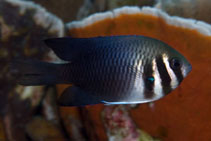| Family: |
Pomacentridae (Damselfishes), subfamily: Pomacentrinae |
| Max. size: |
13.5 cm TL (male/unsexed) |
| Environment: |
reef-associated; marine; depth range 10 - 45 m, non-migratory |
| Distribution: |
Western Central Pacific: Indonesia, the Philippines, New Guinea, and the Solomon Islands. |
| Diagnosis: |
Dorsal spines (total): 13-13; Dorsal soft rays (total): 12-14; Anal spines: 2-2; Anal soft rays: 13-14. Description: Adult body greyish brown, head and anterior body vertical bars alternating brown and white on ventral side, pelvic fins white (Ref. 90102). Juveniles dark posteriorly with large black ocellus at mid-base of dorsal fin, on large adults, bars on head become brown and lower anal fin becomes yellow (Ref. 37816). Small juveniles bright yellow with black band, gradually changes to an all black posterior body when adult (Ref. 48636). Body depth 1.7-1.9 in SL (Ref. 90102). |
| Biology: |
Adults inhabit coral-rich areas of outer reef slopes (Ref. 9710). They occur in small groups. Juveniles stay close to substrate but adults may swim high above to feed on zooplankton (Ref. 48636). Oviparous, distinct pairing during breeding (Ref. 205). Eggs are demersal and adhere to the substrate (Ref. 205). Males guard and aerate the eggs (Ref. 205). Diurnal species (Ref. 113699). |
| IUCN Red List Status: |
Least Concern (LC); Date assessed: 23 September 2021 Ref. (130435)
|
| Threat to humans: |
harmless |
Source and more info: www.fishbase.org. For personal, classroom, and other internal use only. Not for publication.
